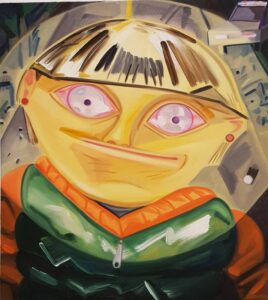by
The Critical Tourist
Curated by the local Visual Arts Center, a series of twenty-five watercolors and drawings on paper by Sajal Sarkar was exhibited at the Free Public Library of the city of Summit in New Jersey from June 1 to July 31, 2019. Four years ago, the artist permanently moved to the United States from India. The series, “Perilous Home”, a body of work done in the last three years, represents a noticeable turning point from the work Sarkar made before his move—paintings, prints and sculptures dominated by realistically rendered nude human bodies. The departure of this series is striking, due not simply to the absence of human figures, but also to radical shifts in formal and conceptual decisions. Sarkar has never been a committed abstract painter, yet these images flirt with abstraction just enough to introduce a fresh dimension to the articulation of form, subject, and meaning. It is necessary to take a quick detour through certain crucial junctures in the history of modernist abstract art before returning to Sarkar’s work to clarify my point.
Of all the debates and discussions provoked by modern art through the last century, some of the most passionately contentious ones have involved the subject of abstraction. It is the question of appreciation of an image that does not faithfully mirror the visible –or more precisely, material—reality, the question of its worth as art, which has made the gulf between the “art world” and the “public” the widest.[i] Material reality, however, was always the starting point in the experiments with abstraction in prewar European painting. Pioneers like Kandinsky, Mondrian, and Malevich, all of them highly trained in the academic means of emulating nature, dismantled material reality through a gradual process to achieve the pictorial integrity they sought. In other words, one’s understanding of their simultaneous awareness and rejection of material reality is indispensable to one’s appreciation of their work. Such noted modernist critics as Roger Fry and Clive Bell used terms like “Significant Form” and “Ultimate Reality” to enthusiastically endorse that early formal investigation, generating a confident rhetoric that bestowed a transcendental status to what was in essence deeply personal, quasi-spiritual visions of white male artists. Eurocentric utopias held by modernist abstract artists thus came to be seen as universally relevant.[ii]
In the wake of World War II, when the hub of modern Western art shifted from Paris to New York, a group of middle-aged –mostly male– American painters drew on that European legacy, but pursued a different avenue to forge their own, American brand of abstraction. Theorized by influential critics (of whom Clement Greenberg was the most prominent), the New York School artists painted large canvases. Rather than starting from descriptive material reality beyond painting, they considered the materials and processes of painting itself –paint, canvas, the act of painting– as their point of departure.[iii] The European rhetoric of Significant Form and Ultimate Reality was thus replaced by one that underscored the physicality and essence of painting as a medium.[iv]
Despite their differences, there were two significant overlaps between prewar European and postwar American abstract art, both of which were asserted more forcefully in the latter discourse: first, divorce from extraneous subject and content, with the adamant claim of detachment from material life; second, assertion of a universality that transcended specificities of cultural and other contexts. In fact, sidestepping his own racial and gender identities, the (male) New York School artist identified himself as both “American” and the universal subject; and the exploration of material and process by this subject became the sole content of his art.[v] Such decisive endorsement of an iconoclastic, self-referential “non-figurative” art –often described by the populist label “formalism” and empowered by the universalist identity of the artist– established the international status of Abstract Expressionism in the postwar years.
And yet, paradoxically, the discarded material reality implied by the term “non-figurative” and such synonyms as “non-objective”, “non-representational” and so on, has always lingered in the shadows of all abstract art. For if “figuration” signifies not just human or animal figures, but any reference to anything material and visible, then any notion of “pure” abstraction turns out to be a myth, as the most non-figurative gesture on a surface is always capable of invoking visible and material experience, even if remotely. All intelligent abstract painters have occasionally produced images that betray their awareness of this myth of abstraction. Malevich’s iconic White on White (1918), a sort of culmination of what he called his “Suprematist” experiments, is a case in point. Passionately essentializing all references to material reality into colored rectangles interacting on white canvas, Malevich ultimately made this uniquely simplified image, which, with a remarkable twist, refers back to material reality: it can also be read as a tilted blank canvas mounted on a white wall. It brings Malevich’s investigation of abstraction to a full circle, unequivocally demonstrating that far from being mutually exclusive (as the populist debate in modern art between the “art insiders” and the “public” might suggest), pictorial realism and abstraction are always in a symbiosis, each embedded in the other. Needless to say, the duality of visual perception in Malevich’s painting also demands duality of subject, now that the drastically simplified geometric shapes acquire a concrete identity (tilted canvas on a wall). Much of the abstraction of the postwar years, particularly those by the American Minimalists (Frank Stella’s early images of pin stripes, among others) were informed by the awareness of this underlying paradox in the discourse of abstraction, where iconoclasm was rhetorical, at best.
Following the Pop movement’s challenge to the elite rhetoric of the New York School, this myth was further exposed –most intensely in the American scene, but also in western Europe — to intellectual inquiry, when the very premise of abstract art was critically dissected between the 1970s and the 1990s—the era of postmodernism. The many fashionable gestures and ephemeral trends of this period aside, one of its insightful contributions to the critique of modernism (to the chagrin of many ill-educated artists to date) was that projection of the abstract artist’s subjectivity with any claim of universal validity was no longer tenable in a heterogeneous world. This meant, first of all, that pursuit of abstraction would be relevant if mediated by self-reflexivity, such as through irony; second, in case of any committment to some sort of spiritual vision, it would have to be offered as the exclusive product of the artist’s own earnestness, with no prospect of being perceived as a symbol of a collective utopia; and finally, despite its apparent isolation from material reality or perceivable subject and content, the image as well as its maker would be unambiguously recognized as products of a historically specific value system.
The fact is, albeit marginalized during the above period of scrutiny, abstract art was never extinct. The revisionist tide, in fact, opened the doors to a fresh surge of an immense variety of experimental abstract art –often labeled New Abstraction– around the turn of the century by freeing it from its previous mandates, including the prerogative of white male artists.[vi] This explosion of heterogeneity has indeed been a liberating scenario for artists from diverse backgrounds. Spearheaded by artists of color and of various sexualities and genders, a largely self-conscious abstract art has emerged over the last couple of decades where incisive political and social subjects are playfully concealed beneath energetic explorations of material and process on immense canvases (a nod to the New York School), demonstrating the artists’ sharp awareness of history. Mark Bradford, Julie Mehretu, Chris Ofili and Nari Ward are among those who stand out on this front, all of whom exploit abstraction’s apparent detachment from material reality to encode it with signs from that same reality.[vii]
Sajal Sarkar’s work, however, has no apparent kinship with the playful iconoclasm of any of these artists. Unlike them, Sarkar was not trained to be aware of the grandeur and influence of Abstract Expressionism, as the New York abstraction never had much impact on modern Indian art when Sarkar went to art school in India. Thus, contrasting the commanding presence of their paintings, Sarkar’s watercolors and drawings on paper are far more intimate. They seem to blend with their surroundings due to the delicate treatment of material and their modest scale. If, in fact, one considers the dominance of realistic human bodies in Sarkar’s past work, then the production of this series seems more akin to the European strategy of essentializing material reality, rather than the American mode of self-referential abstraction; the motifs in these images appear radical simplifications of the realistic imagery in the artist’s production from a few years ago. Yet where “Perilous Home” falls in line with the works of the artists I cite above is its persistent reference to subjects and concepts that would be ceremoniously dismissed as extraneous in the traditional discourses of abstract art. The potent ideas buttressing Sarkar’s images take advantage of the myth of abstraction to engage in vibrant dialogs with the elements of pictorial construction, material and process. I find this a compelling reason to include Sarkar in the company of these artists.
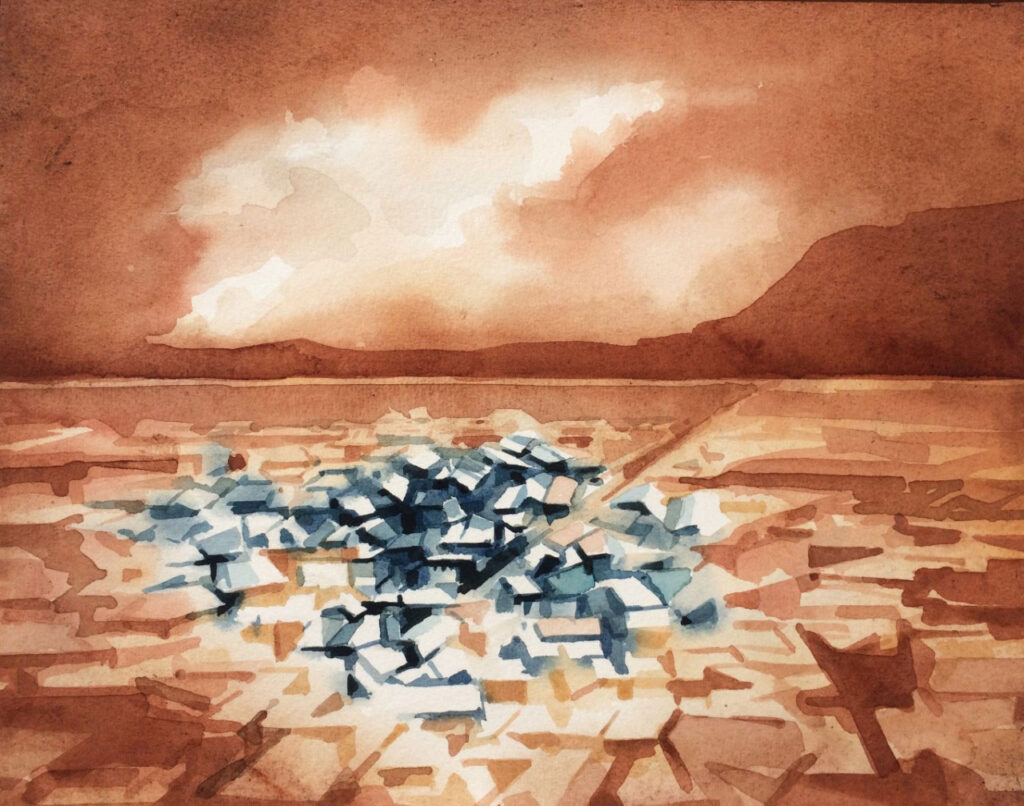
Perilous Home, watercolor on paper, 2016.
Most of them monochromatic, the exhibits can be loosely grouped into two types, with a handful bordering on both. Quasi-abstract compositions present discernable referential subjects in one group, while design dominates in the other, privileging surface over representation of space. Both, however, were made between 2016 and 2019 (after his move to America), in no strict sequence, which is why my observations do not claim any chronological significance in the production of these images.

Perilous Home, watercolor on paper, 2016.
Both material and process in Sarkar’s work are radically economized, but the effects are impressively nuanced. Let go on a damp surface, paint in the first group of water-colors is first allowed to take its natural course, albeit under dexterous control; and once the surface has dried, subtle tints are applied judiciously. The effect is countless tones bleeding into one another, lending themselves to intimate visual inspection that lead to discoveries of controlled accidents. Dried puddles, blotches, blots and stains that are lifeless, even ugly on close scrutiny show dynamic interactions when perceived in their pictorial entirety. The picture plane in some of these images is bisected, forming two segments that are often linked by a motif that controls the entire composition with remarkable precision. Yet while involved in such formal play, one becomes equally aware of the referential role of these pictures, most of which are horizontally composed: they are panoramic landscapes. The bisection, a well-known trope of landscape painting, serves as the horizon, with a subtle curve referring to the circularity of the planet. The tranquility that such a horizon line usually brings to a landscape, however, is either harshly invaded in these pictures by powerful forces, or an impending doom lurks in the background. For instance, dark clouds on the upper left of an apparently innocuous valley scene depicted in reddish brown, echoing the hills on the right, threatens to engulf the lighter clouds in the upper middle. The distant dwellings in the valley, rendered in blue, appear huddled, as if to survive an unseen threat. This clustering effect is enhanced by the masterful transition from blue to soft tones of brown through the rest of the land, making it uncertain whether the other shapes are also houses or simply land destroyed by a malicious force. As a matter of fact, the dominance of reddish brown generates a sort of unease to the overall mood—it brings to mind the fiery glow following a devastating explosion. This observation is confirmed by another vertically composed picture, where a broad band of brushwork divides the picture plane from top to bottom through the middle, with a cluster of shadowy forms below. Its alternative reading as a passing force, such as a meteor or a missile storming through a human habitat, certainly makes sense.
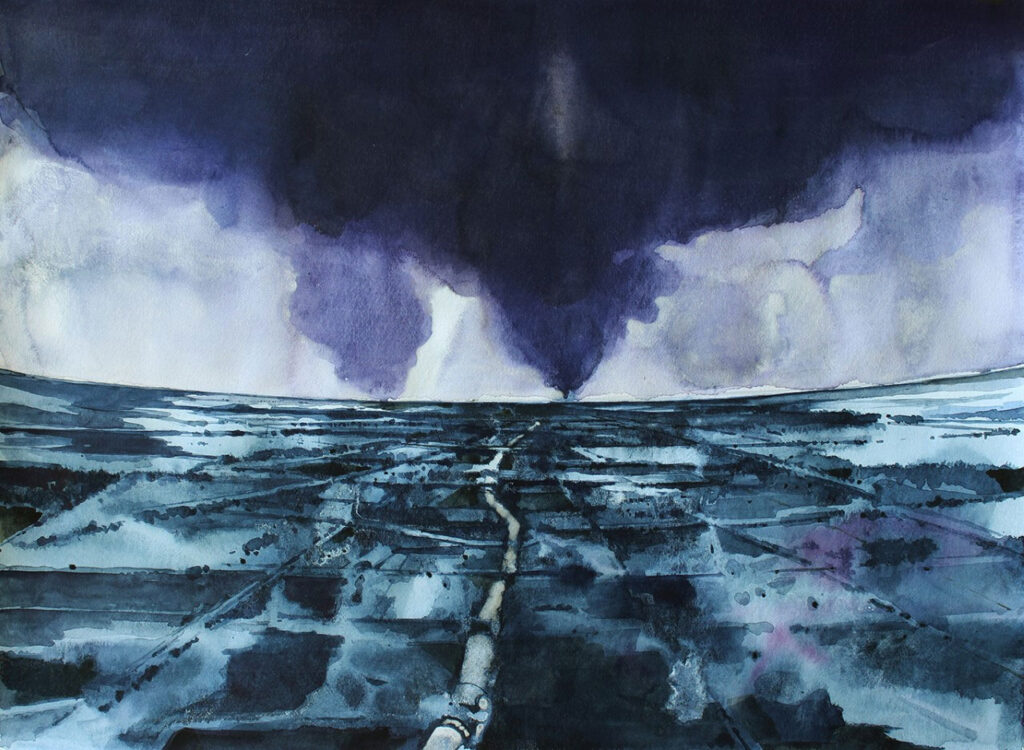
Color schemes change in the other works of this type, with blackish blue pervading a couple of them. One shows a curious serpentine shape in the middle of a dark, segmented lower half, reaching the boundary of the bisection. Around the spot toward which this motif tapers off, a massive dark shape rises upward, covering majority of the upper section like a giant umbrella or a funnel, leaving an almost symmetrical space on either side for lighter stains and blotches. The compositional balance of this picture is impeccable. But no sooner does one begin to admire all the formal maneuvers than the scene exposes its other identity: running through what is perhaps a vast agricultural land, the serpentine motif turns out to be an oil pipeline, which then re-presents the mysterious yet majestic shape in the sky as a giant plume of toxic smoke caused by some form of destruction at an oil-well or refinery in the distance. The lighter plume to the left compounds the drama of the calamity, while the desolation of the scene makes it more ominous than those showing human settlements. Despite their modest scale, these paintings stir one’s memories of the foreboding silence of Anselm Kiefer’s large apocalyptic landscapes in reference to the Holocaust.
These pictures ably demonstrate that Sarkar’s creative thinking is deeply affected by crises of humanity. The artist, in fact, is unequivocal about this. “…I am deeply affected by the relentless cycle of violence in various parts of the world and the immense suffering it has been causing”, says Sarkar. “My deepest concern is about never-ending wars, industrial and environmental pollution and our excessive consumption of natural resources threatening our very existence”.
[viii]
It is intriguing how the notion of “home”, included in the show’s title, functions in this context. Born in the province of West Bengal in India in the 1960s, Sarkar was a child when the region became a hub of an ultra-left insurgence in the early 1970s, seeking a socialist revolution. Later in life, settled in the province of Gujarat as a practicing artist, he witnessed a devastating ethnic riot there in 2002. Always touched by such tragedies, Sarkar’s anthropocentric work in that period featured human bodies writhing in agony. Then in 2016, he immigrated to the United States with his family, only to experience the resurfacing of an ugly, intolerant side of American society that had been on leash for decades. He has since been struggling not only to negotiate his relationship with his adopted home, but also to locate his niche within an unfamiliar art world, having uprooted a reasonably active career in India. This major change in the trajectory of his life, I argue, has made Sarkar abandon his allegiance to realism and invent a fresh visual language for his work. He has reshaped his more confrontational notions about life, death and suffering into a more inward-looking existential vision—a spiritually-inclined position, if you will. And this shift in his mode of thinking in the late middle phase of life, I think, is responsible for his strategic use of abstraction –or rather the myth of abstraction—to speak of human suffering and the planet’s malady. Amid the current political climate in the United Sates as well as elsewhere in the world (including India), where a specific notion of “home” is being aggressively politicized as an excuse to exclude, even persecute specific others, uncertainty about belonging to an actual place has driven Sarkar to forge a conceptual space in his recent work. In this invented space, “home” itself emerges as an abstraction, a malleable idea that his “deep compassion for human life and spirit…” helps him to shape and reshape while exploring the perils of the physical world around him. It provides room for his meditations on humanity.

In what can be labeled a subsection within this first group of paintings, the panoramic landscapes make way for a different strategy: Sarkar zooms out to erase most descriptive details and specificities of the landscapes, paying more attention to design. In one such image, a large circular shape is set against a brilliant blue backdrop, with an illuminated edge around the circle separating the two areas. Majority of the circle is covered by an intricate web of branch-like patterns, demonstrating impressive handling of watercolor, which gradually fades into white on the lower right. The sense of volume created by the shadows within the web and the touch of dark on the lower right edge presents the circle as a sphere, leading one to read it as an eclipsed, decrepit earth with exposed arteries and veins under its ripped skin, an apocalyptic symbol of a troubling present and a bleak future viewed from outer space. This pictorial strategy, however, is reversed in another painting with the same structure: the dense, layered web is
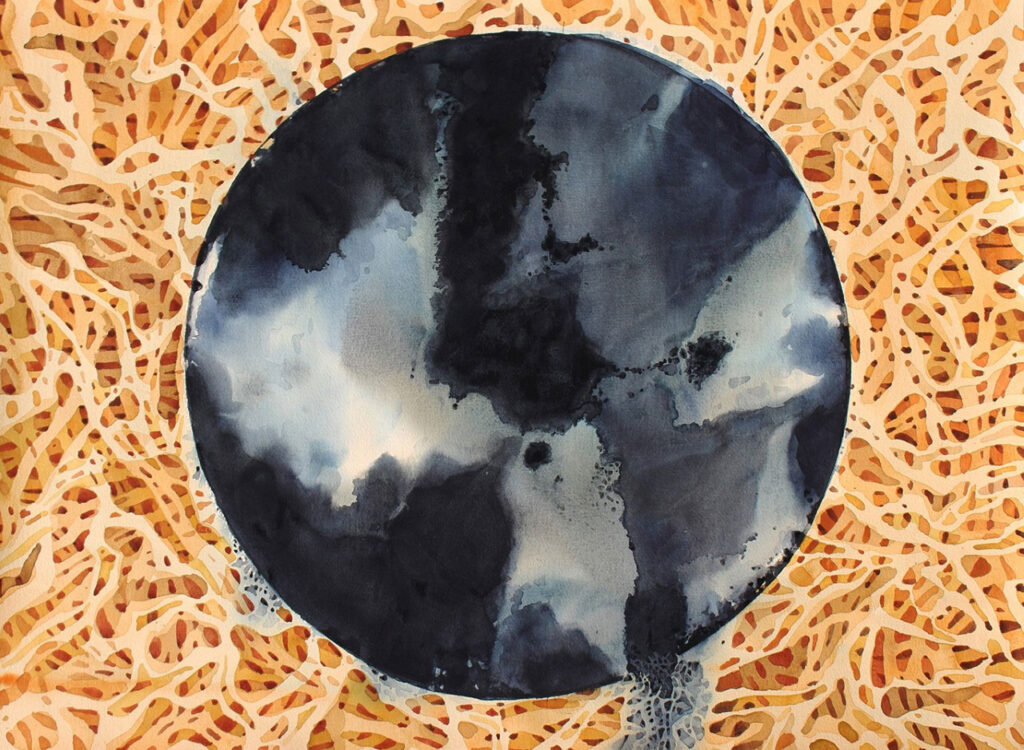
transferred to the background, whereas the circle/sphere is covered with rich tones of blackish blue. While the nuanced tones account for the continental maps and oceans, the paint curiously bleeds out into the web in several spots. In yet another picture made with watercolor, gouache and mica pigment, a much
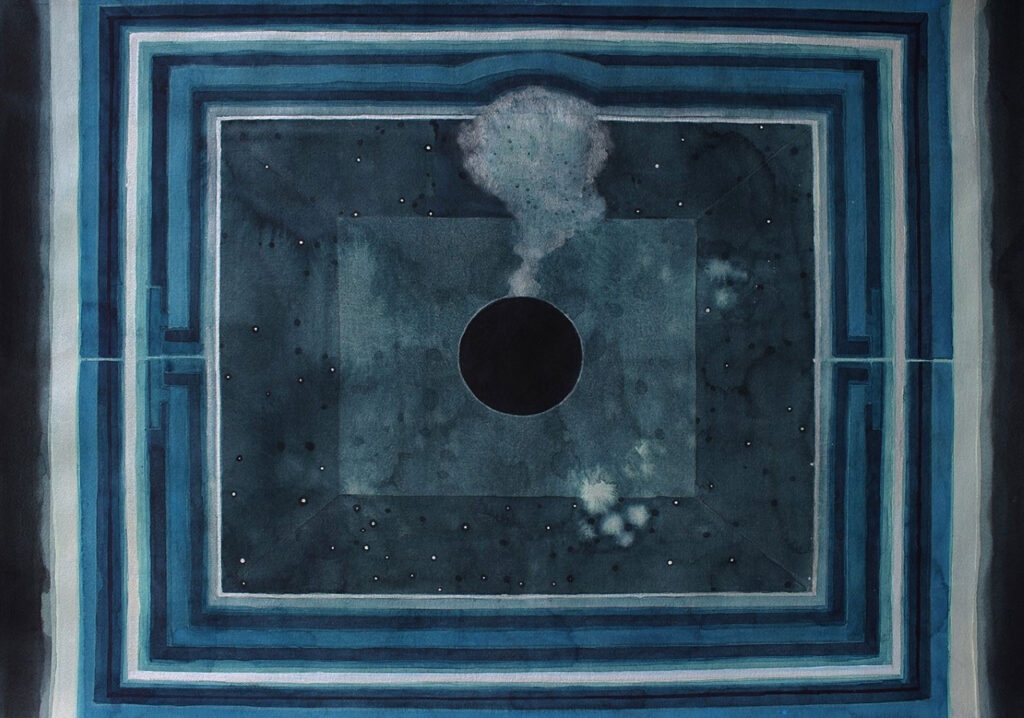
Untitled, watercolor, gouache & mica pigment on paper, 2017.
smaller circle is placed at the center, tightly framed by several successive bluish-gray rectangles. Amorphous shapes emerge from the circle, the largest of which wants to escape the rectangular barrier. Tiny luminous dots populate the two of the innermost rectangles. What does one see here? Is it primarily a formal experiment with geometric shapes, punctuated by a few organic ones? Is it a drastic close-up of some machine with a hole, emitting smoke? Or is this a framed picture-within-a-picture of a dying planet taking its last breath, with stars as the only witnesses of its demise? Perhaps the cold, metallic surface of the frames invites one to understand the circular shape as a dark hole, to imagine peeking through it into a frightening unknown? Ambiguity prevails.
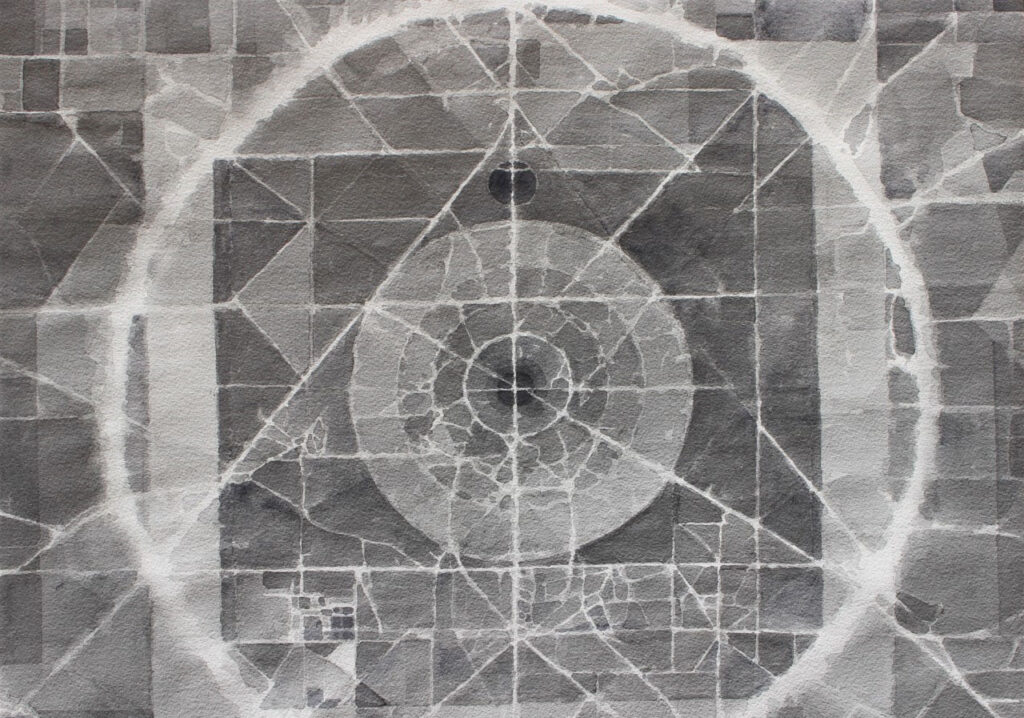
The paintings in the second group are distanced even farther from any reference to material reality. All but one or two rendered in monochrome, shapes and layered tones in these images engage in a complex formal play, colliding, overlapping, bleeding into one another. The circles and webs expand and multiply with a life of their own, with little connection to anything else beyond the pictorial domain. Compared to the somber mood and dark allusions of the other group, some of these images feel considerably lively and welcoming. Their formal treatment has an “allover”-ness (to borrow a Greenbergian term) that makes them stand apart from the others. While their titles occasionally indicate an imagined peek into molecular structures, surface, design and pictorial integrity far outweigh any such clues. I argue, however, that understanding of the pictures in the other group is crucial to the appreciation of these apparently self-referential ones. For me, these abstract paintings testify to Sarkar’s undaunted optimism about life. Determined to not lose hope, he employs the visual components of his apocalyptic scenes –the dark planet, the web, the bleeding color— to explore formal beauty and subtlety amid all the agonies and perils that otherwise remain central to his work. Far from digression, this seems an exercise that empowers the other pictures that present discernible content. In short, this batch of images introduces a particularly sophisticated edge to Sarkar’s creative enterprise.
When walking up to the very large canvases by Mehretu, Bradford, Ofili or Ward, one carries to that encounter a hidden expectation of discovering something other than form and design; the scale of their works inevitably demands that from the viewer. What especially draws me to Sarkar’s recent work is that it delivers the same outcome, but in a different way. One is first enticed by the delicate tones produced by soft-natured materials, balanced design, and the manageable scale of his images, without any expectation of anything more than beholding conventional beauty. Once engaged, however, one is engulfed by the disturbing messages of the work, awakened to the fact that what looks innocuous imagery at first glance can, on close inspection, reveal so much about atrocity and suffering concealed beneath that trope of beauty. Concealment, however, does not imply disguise, which, by definition, is something fake hiding something else that is authentic. Sarkar’s work touts no utopia. Like the four artists above, design and object, form and content are always in a symbiosis in his work, in a dialogic relationship, as in Malevich’s White on White. It is this dialog between abstraction and realism, between deep introspection about life and actual lived experience that enables him to make the viewer step out of all their subjectivities about home and objectively watch its perils, like an out-of-body experience. Once the prerogative of white male artists, the discourse of abstract art is now a space for offering a diverse range of visions and agendas. And Sajal Sarkar joins the company of the artists already active in it to further enrich that arena.
Postscript:
It is the initially non-intimidating nature of Sarkar’s work that unfortunately worked to his disadvantage at this exhibition, which was installed on a wall in a narrow passageway at one barely noticeable end of the book-stacks (supposedly the library’s designated gallery). Only those approaching an elevator located nearby would notice the pictures– and even that, if one was waiting for the elevator to arrive. The effort that went into curating the show, and more importantly, into making the images, would have been a rich experience for the visitors, had the images been displayed at a more prominent spot in the building. In fact, it would not be a stretch to see the location and the reception of this show as a metaphor for the currently marginalized status of an immigrant artist in American culture, struggling to find his foothold.
Notes:
_________________________
[i]
My use of the term “abstraction” here precludes age-old conventions of abstraction dominant in visual cultures of many societies, especially those outside the Western world. Here I approach abstraction in visual images as a specific intellectual enterprise that emerged in the Western world roughly a century ago, as a consequence of modernism’s critique of the convention of emulating nature. Furthermore, I keep this discussion limited to painting. The dialogic role of modern sculpture with abstract painting constitutes an extremely rich discourse that is indeed closely connected to the points I make in this essay. But I set it aside for the sake of concision, while fully acknowledging the crucial role of that subject for a more comprehensive presentation of this thesis.
[ii]
While abstraction in art owed its origin to various sources, including investigations by some artists into the paranormal, the mode of inquiry and rhetoric I discuss here have been unequivocally privileged in modernist art histories.
[iii]
While the artists of the New York School were often in disagreement with Greenberg’s insistence on the materialistic rationale for their art in favor of exclusively personal perspectives not unlike those of their European predecessors, the incisive writings of Greenberg and other critics that actively championed their art abroad through the 1950s have nonetheless formed the theoretical groundwork of Abstract Expressionism.
[iv]
Popularly nicknamed Abstract Expressionism down the road, this materialistic abstraction bred three different stylistic trends: gestural abstraction (such as Pollock, deKooning, Motherwell, Rothko, Kline), chromatic abstraction (such as Newman, Still), and a little later, color-field painting (such as Frankenthaler, Louis).
[v]
See Ann Gibson,
“Recasting the Canon:
Noman Lewis and Jackson Pollock”. Artforum International, March 1992, pp. 66-73. This creative enterprise of large-scale abstract paintings was upheld as a symbol of the freedom of the American painter, which was a distinctly American version of postwar existentialist thinking. Unlike its European counterpart, this mode of thinking was unaffected by the trauma of the War, as the United States was unscathed by it.
[vi]
See: Barbara A. MacAdam, “The New Abstraction”,
ArtNews, April 1, 2007. http://www.artnews.com/2007/04/01/the-new-abstraction/ Thomas Micchelli, “New Abstraction: 45 Years in the Making”, Hyperallergic, June 1, 2013.
https://hyperallergic.com/72262/new-abstraction-45-years-in-the-making/
_______________________________________________________________________________________________________________________
Indignantly named “Zombie Formalism”, a large portion of this deluge of abstraction has been harshly criticized for its complicity with a shifty and scheming art market that momentarily uses outputs of young artists simply as attractive commodities. See: Jerry Saltz, “Zombies on the Wall; Why Does So Much Abstraction Look the Same?”, Vulture, June 17, 2014. https://www.vulture.com/2014/06/why-new-abstract-paintings-look-the-same.html. Chris Wiley, “The Toxic Legacy of Zombie Formalism…”, Parts 1 & 2, artnet news, July 26 & July 30, 2018. https://news.artnet.com/opinion/history-zombie-formalism-1318352;
https://news.artnet.com/opinion/the-toxic-legacy-of-zombie-formalism-part-2-1318355
[vii]
This mode of abstraction predates these younger artists, such as in the case of Harmony Hammond, but did not draw as much attention as it does now. See: Holland Cotter, “Harmony Hammond’s Art is Is Bold and Prickly as Ever”, New York Times, August 8, 2019. https://www.nytimes.com/2019/08/08/arts/design/harmony-hammond-aldrich.html?fbclid=IwAR3t8_IZ-6gtgoidbfZ6kLqpVOV9Yh65K0RQQkTzX69A8x5vQBGtocuQRrw
[viii]
Sajal Sarkar, “perilous Home” catalog, 2019.



